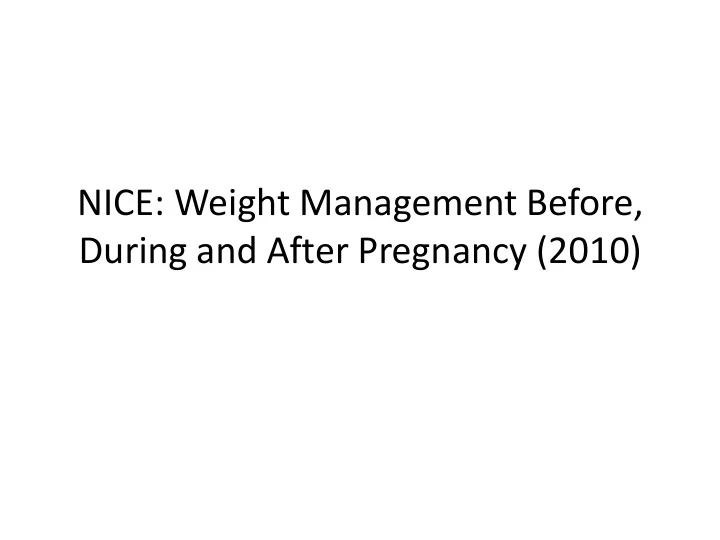

NICE: Weight Management Before, During and After Pregnancy (2010)
This Guidance Does Not Cover: • women who are underweight (that is, those who have a body mass index [BMI] less than 18.5 kg/m2) • clinical management of women who are obese during pregnancy • those who have been diagnosed with, or who are receiving treatment for, an existing condition such as type 1 or type 2 diabetes • food safety advice.
Changing Behaviour Evidence-based behaviour change advice includes: • understanding the short, medium and longer-term consequences of women’s health -related behaviour • helping women to feel positive about the benefits of health- enhancing behaviours and changing their behaviours • recognising how women’s social contexts and relationships may affect their behaviour • helping plan women’s changes in terms of easy steps over time • identifying and planning situations that might undermine the changes women are trying to make and plan explicit ‘if–then’ coping strategies to prevent relapse.
Achieving and Maintaining a Healthy Weight • base meals on starchy foods such as potatoes, bread, rice and pasta, choosing wholegrain where possible • eat fibre-rich foods such as oats, beans, peas, lentils, grains, seeds, fruit and vegetables, as well as wholegrain bread and brown rice and pasta • eat at least five portions of a variety of fruit and vegetables each day, in place of foods higher in fat and calories • eat a low-fat diet and avoid increasing their fat and/or calorie intake
Achieving and Maintaining a Healthy Weight • eat as little as possible of fried food; drinks and confectionery high in added sugars (such as cakes, pastries and fizzy drinks); and other food high in fat and sugar (such as some take-away and fast foods) • eat breakfast • watch the portion size of meals and snacks, and how often they are eating • make activities such as walking, cycling, swimming, aerobics and gardening part of everyday life and build activity into daily life – for example, by taking the stairs instead of the lift or taking a walk at lunchtime • minimise sedentary activities, such as sitting for long periods watching television, at a computer or playing video games • walk, cycle or use another mode of transport involving physical activity.
Supporting Women After Childbirth • During the 6 – 8-week postnatal check, or during the follow-up appointment within the next 6 months, provide clear, tailored, consistent, up-to-date and timely advice about how to lose weight safely after childbirth . • Ensure women have a realistic expectation of the time it will take to lose weight gained during pregnancy. • Discuss the benefits of a healthy diet and regular physical activity, acknowledging the woman's role within the family and how she can be supported by her partner and wider family. • Advice on healthy eating and physical activity should be tailored to her circumstances. For example, it should take into account the demands of caring for a baby and any other children, how tired she is and any health problems she may have (such as pelvic floor muscle weakness or backache). • Health professionals should advise women, their partners and family to seek information and advice from a reputable source . Women who want support to lose weight should be given details of appropriate community-based services.
Supporting Women After Childbirth • Health professionals should give advice on recreational exercise from the Royal College of Obstetrics and Gynaecology. • In summary, this states that: – If pregnancy and delivery are uncomplicated, a mild exercise programme consisting of walking, pelvic floor exercises and stretching may begin immediately. But women should not resume high-impact activity too soon after giving birth. – After complicated deliveries, or lower segment caesareans, a medical care-giver should be consulted before resuming pre-pregnancy levels of physical activity, usually after the first check-up at 6 – 8 weeks after giving birth. • Health professionals should also emphasise the importance of participating in physical activities, such as walking, which can be built into daily life
Recommend
More recommend